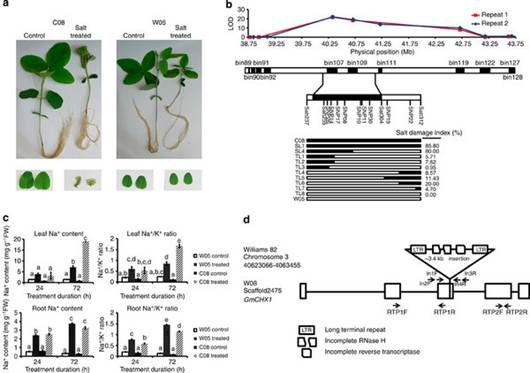野生大豆中发现新的耐盐基因
来源:《自然—通讯》
作者:Xun Xu
时间:2014-08-21

由香港中文大学、华大基因等单位联合完成的野生大豆W05的全基因组测序工作,通过对野生大豆重要农业性状关联基因研究,发现了新的耐盐基因。7月10日,最新研究成果于《自然—通讯》杂志在线发表。
大约6000至9000年前,我国就开始进行野生大豆的驯化。驯化过程中,大豆的栽培种丢失了很多与环境适应相关的重要基因,然而这种缺失的遗传多样性可以通过育种的方法进行改良,也就是说可以将野生大豆中能够适应某一特定环境的基因重新引入到栽培大豆中。科研人员对野生大豆进行了全基因组测序,并利用一种新颖且有效的研究策略来挖掘野生大豆基因组遗传信息。他们构建了基于测序的基因分型遗传图谱,并利用之前获 得的大豆种质资源的重测序数据,发现了新的耐盐基因,在盐胁迫条件下,该基因负责维持较低的钠离子与钾离子比率,以增强大豆的耐盐性。
盐化作用对于农业构成了严重的威胁,影响全球20%灌溉地作物的收成。在盐胁迫条件下,野生大豆表现出很高的耐受性,因此对于提高大豆的耐盐性改良而言,野生大豆拥有非常好的遗传资源。研究人员还发现拥有完整耐盐基因序列是大豆祖先共有的特征,对盐比较敏感的栽培大豆的后代积累了不同类型的基因突变。这些变异导致耐盐基因功能异常或者低表达。
华大基因该项目负责人谢敏表示,首次发现新的耐盐基因与野生大豆耐盐性相关,仅仅只是一个开始,野生大豆W05基因组序列的发布,将助力解析野生大豆的优良性状,为育种和改良实验提供宝贵的资源。(来源:科技日报 刘传书)
Identification of a novel salt tolerance gene in wild soybean
by whole-genome sequencing
Abstract Using a whole-genome-sequencing approach to explore germplasm resources can serve as an important strategy for crop improvement, especially in investigating wild accessions that may contain useful genetic resources that have been lost during the domestication process. Here we sequence and assemble a draft genome of wild soybean and construct a recombinant inbred population for genotyping-by-sequencing and phenotypic analyses to identify multiple QTLs relevant to traits of interest in agriculture. We use a combination of de novo sequencing data from this work and our previous germplasm re-sequencing data to identify a novel ion transporter gene, GmCHX1, and relate its sequence alterations to salt tolerance. Rapid gain-of-function tests show the protective effects of GmCHX1 towards salt stress. This combination of whole-genome de novo sequencing, high-density-marker QTL mapping by re-sequencing and functional analyses can serve as an effective strategy to unveil novel genomic information in wild soybean to facilitate crop improvement.
原文链接:http://www.nature.com/ncomms/2014/140709/ncomms5340/pdf/ncomms5340.pdf




